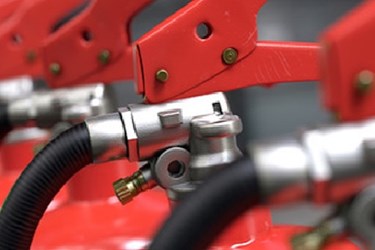Is Clean Firefighting Equipment Part Of Your Food-Safety Plan?
By Laurel Maloy, contributing writer, Food Online

Firefighting equipment is critical to your food facility’s safety and its cleanliness ensures not only proper functionality, but also ensures not being a catalyst of contamination
The seventh challenge of the HACCP mentor addresses something that every single facility has but, due to its commonality, is often overlooked. When is the last time you looked at your firefighting equipment? Not to check its functionality — which is, of course, critical — but when is the last time you checked it for cleanliness?
Regardless if your facility functions under Hazard Analysis and Critical Control Points (HACCP) or Hazard Analysis and Risk-Based Preventive Controls (HARPC), firefighting equipment should be addressed. As a food-safety issue, fire hose housings, fire hoses, fire extinguishers, fire equipment cabinets, fire blankets, and even the innocuous fire alarm pull, all present risks for foodborne contamination. Food-safety auditors will often find these items covered with residue from food processing ingredients, as well as with dust, grime, and grease. Barely noticed, except when the fire department performs inspections, the persons responsible for this life-saving equipment are probably not well-versed in food safety. Chances are your fire extinguisher has a current tag attached in accordance with the law, but is the associated equipment clean?
Pests actually love firefighting equipment as these places are rarely disturbed. Hoses and cabinets are an ideal breeding ground for cockroaches. Food residues and the widely-overlooked, dirty environment contribute greatly to their happiness and prolific breeding. Auditors have found huge colonies of the pests residing quite happily within the coils of firefighting hoses. In fact, your pest management program may be concentrated on the most-obvious sources, while inadvertently ignoring the elephant in the room. In some instances, an effective pest management program is forcing these pests to look for other places to take up residence. Unintentionally ignored firefighting equipment may look quite attractive.
Rodents, as well as cockroaches, just to mention a couple, particularly enjoy the safety, security, and warmth provided by fire blankets. Rolled, folded, and rarely disturbed, fire blankets can harbor any number of pests. Their insulation ensures protection against cold, heat, and moisture, while the very nature of a fire blanket guarantees a relatively risk-free environment in which to eat, sleep, and breed.
Preventing pests from making a home in fire equipment starts by mapping the locations of each piece of firefighting equipment within your facility. Address and clarify inspection, cleaning, and maintenance procedures, putting it all in writing, as required by the Food Safety Modernization Act (FSMA). Going as far as taking before and after pictures as a means by which to obtain the desired result, and to assist with training, may prove beneficial. Photos will provide a reference for what “good” or “unacceptable” looks like. While mapping each firefighting tool, determine the best means by which to check for pest activity, how to eliminate the pests, and then how to prevent the homesteading from reoccurring. If using chemical prevention, be sure to check with the manufacturer as to prevent unintentional damage to the equipment; it must work as it is intended, when needed.
Integrated Pest Management (IPM) is an integral part of FSMA. However, as every facility is gearing up for implementation and dreading the first inspections under its new rules, there are bound to be hiccups. This is a historical period of time in the food processing industry and serves as a time for sharing information for the good of the whole. Informational articles, educational opportunities, and the on-going review of your food-safety and food-defense plans will ensure your company’s compliance and good standing with regulatory agencies.
